The Jewish Burning Man
If COVID couldn’t stop the mind-blowing annual pilgrimage to Rebbe Nachman’s grave, then nothing can
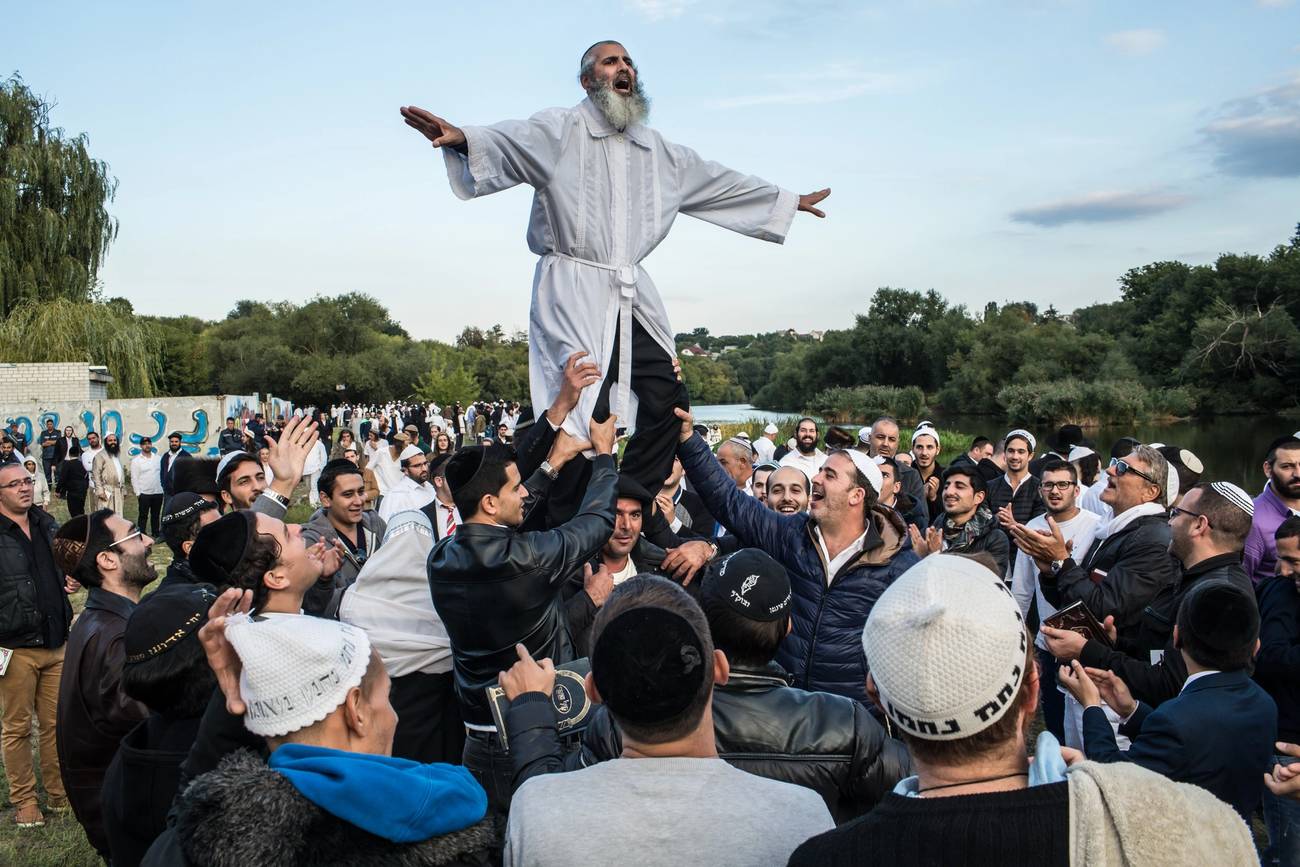


There are some events that are impossible to cancel, even now. In the early 19th century, Rabbi Nachman of Breslov called on the faithful to visit his tomb in the Ukrainian city of Uman every Rosh Hashanah, and since no one can cancel Rosh Hashanah, the pilgrims will come to Uman regardless of whatever obstacles get thrown in their way. Followers of the rebbe have been defying the diktats of various governments, mainly those of the former Soviet Union, in order to get to Uman ever since the first covert pilgrimages in the 1960s. Even in 2020, at the height of COVID lockdowns and travel bans, an estimated 2,000 Jews managed to reach the first and final Breslover Rebbe’s grave, which is about 48,000 fewer than a typical Rosh Hashanah.
I met Pinchas, a wiry young Hasid from Lakewood, New Jersey, with a day job in online sales, at the start of my own six days in Uman this past September. Pinchas was one of those 2,000 who had also celebrated the Jewish new year in Uman back in 2020, outwitting the pandemic travel bureaucracy at a time when most of the world was still frozen in place. It took him three weeks to get there.
Pinchas was both shocked and elated at being allowed into Ukraine. “The happiness when I got out of that airport—I don’t think I was ever that happy. And I’ve got three kids, I’ve gotten married.” He hid for two weeks in an Uman apartment, avoiding police who were on the lookout for Rosh Hashanah pilgrims. In Uman, where the annual Jewish onslaught is vital to the local economy, “people literally kissed my hands ... they saw a Jewish person in the street and they were like wow, a guy came!”
Pinchas’ wife and children support his long absences in pursuit of what people of a less numinous outlook might see as a purely selfish mission. But he said his annual trips to Uman give him the “boost” needed to be fully present and engaged in the lives of his other family members the rest of the year, something they understand, accept, and even encourage. Of Uman itself, this unscenic, midsize dot on the map of one of the poorest countries in Europe, halfway between Odessa and Kyiv, Pinchas says, “I literally feel that my lawyer for the day of judgment—which is Rosh Hashanah—is here.”
I ran into Pinchas again at the very end of the week, on Pushkina Street, among the throngs celebrating the close of Rosh Hashanah. Techno beats and riotous dancing erupted amid the kosher pizza stalls and tchotchke shops of Jewish Uman’s grimy main drag, where a steady stream of black-clad men was already surging toward fleets of buses bound for the airport.
“Last year the streets were empty here,” Pinchas said. “It was dead. We were like 50 people that were dancing. … I davened in the main shul, there was only one minyan.” As he spoke, thousands were packed into a tent dancing to the Hasidic jam band Pumpadisa. The rapper Nissim Black had drawn a similar crowd a few nights earlier. A techno version of a Shlomo Carlebach Kabbalat Shabbat tune boomed from down the street. “Look at the amount of people,” said Pinchas, gazing toward this joyous gathering of Jews from across the world. “Thank God. Thank God for giving me the privilege of being here.”
There is no great architecture in Uman, no domes or vaults of heaven. The aesthetics are characterized by hulking prayer tents and slapdash concrete hotels, many of them sleeping eight to a room in bunk beds while touting the subtle differences between their regular mikvah and their VIP mikvah. The streets are beyond filthy, layered in garbage and religious leaflets and paper plates. They are filled with people, including surly-looking Ukrainian soldiers, Israelis selling discount kittels and shouting over loudspeakers in Hebrew, chain-smoking Yeshiva buchers, and half-crazed pushke-pushers promising your tzedakah contribution will result in your finding a wife within 40 days. All of these people were male, of course.
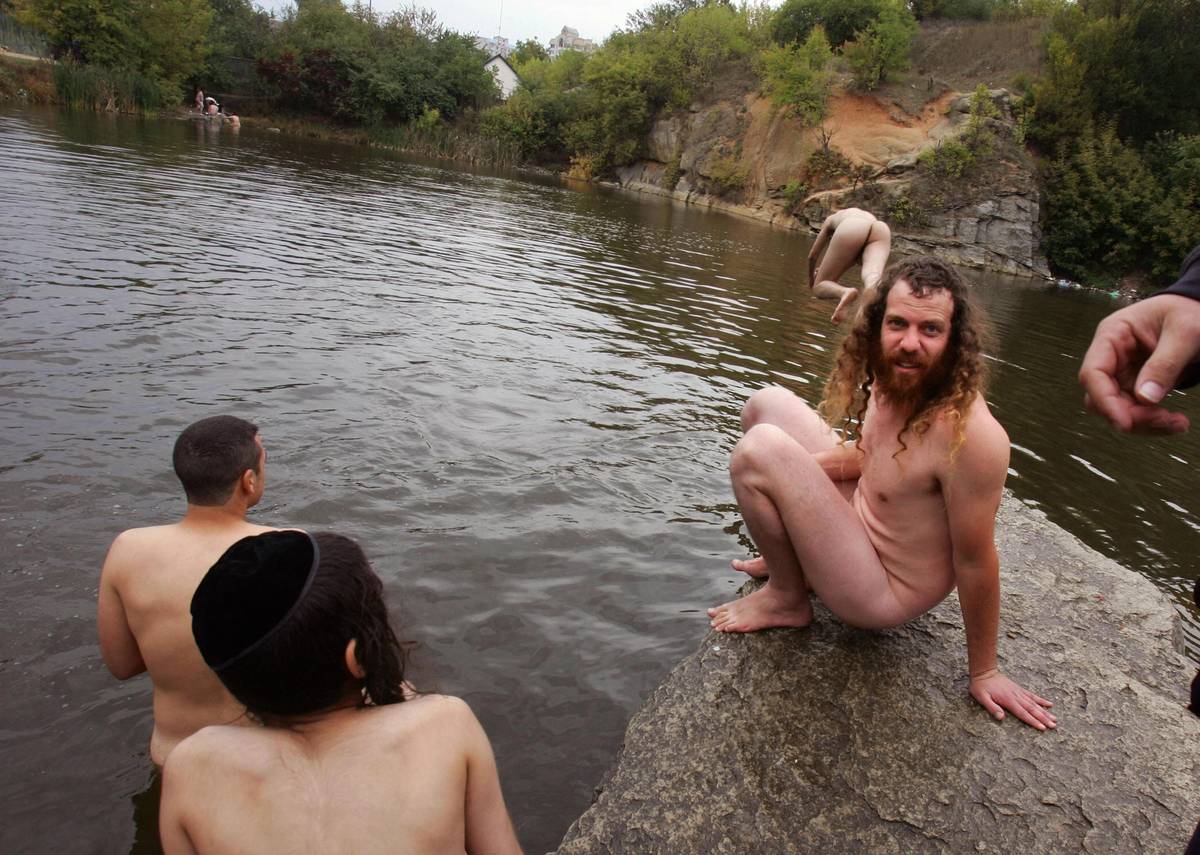
Could the hostels and apartment buildings and banquet halls that are used for less than a week every year, and a holy site that has grown from a single gray marker until it enveloped an entire neighborhood, all be explained only by the expectation of a dead rabbi’s advocacy in heaven? “We refer to Rabbi Nachman as a living rabbi,” said Gil Bashe, an American-born rabbi. On his deathbed, Rabbi Nachman told his Hasidim not to worry about his coming physical demise—once he left this world it would be as if he were going to another room, even if it’s one the living couldn’t enter and that the rabbi couldn’t leave.
“He promised that he’d do everything in his power to bring you out of the depths of hell in this world and the next world,” said a young American studying at a yeshiva outside Jerusalem, who introduced himself as Chayim, when I asked him what had drawn him to Uman. “So I’m like, dude, how can I not?”
There is no surviving image of Rabbi Nachman. When tens of thousands of black-hatters, yeshiva kids, Israeli Sephardim, dreadlocked spiritual seekers, and Jewish miscellany like myself pass through the unspectacular confines of Rabbi Nachman’s tomb, they are not all seeing the same thing. The grave is inside a twin-roofed hall dating from the late 1990s and built on a platform jutting out of the hillside. It feels crowded and lived-in despite being several times bigger than what it replaced. At the time the Soviet Union fell, a concrete slab near a nondescript house on a steep ravine amid a block of dispiriting high-rises was all that marked the rebbe’s resting place. This year, the prayer spaces, side corridors, and study rooms were mobbed with pilgrims every moment of the holiday week, the black memorial cenotaph hidden behind an impenetrable human barrier even at two in the morning.
Rabbi Nachman’s tomb is encircled by new construction, much of it related to the pilgrimage industry. But until World War II it was in the middle of a large Jewish cemetery. And not just any Jewish cemetery: The rabbi chose to be buried in Uman because of the sacrifice of local Jews slaughtered by Cossacks for refusing to convert to Christianity in the 18th century, an event that was already fading from memory in Nachman’s time. “Rabbi Nachman knew that if he wasn’t buried with the 20,000 martyrs, they would be forgotten,” said Bashe. The location of his tomb eerily anticipated future atrocities, as if the rebbe felt he needed to be present during another round of massacres: The Nazis would also bury Jews in mass graves along the bottom of the ravine, less than a hundred feet below Rabbi Nachman’s tomb.
The existence of this annual pop-up community atop centuries of Jewish dead is strange and miraculous and unequaled by any other Jewish event. For a few days, religious men of diverse backgrounds come together to revive the prewar demographics of central Ukraine (Uman has a year-round population of about 82,000). Numerous Jewish worlds of a century ago have all but entirely ceased to exist: Vienna’s cafes and secular Yiddish Warsaw have no real modern analogue; Jewish Baghdad feels as lost and as distant as Babylon. The Moroccan and Indian communities mostly live on as Israeli enclaves that an outsider stumbles across only by accident. Of these vanished prewar Jewish societies, dozens of them forgotten and displaced and destroyed, it is Breslover Hasidism, through the writings and person of its beguiling late rebbe, that has managed to create a single, annual event, open to seemingly every Jewish man, that can serve as a mass reconciliation with a destroyed past. This is the real reason Jerusalem hippies and working-class Israelis and baal teshuva nursing home moguls and Williamsburg Satmars are drawn to Uman, even if it’s all subconscious: They feel the pull and the power, along with the psychic and spiritual nourishment, of returning something to life.
The Uman pilgrimage has always been one of the less explicable annual Jewish events—there are bigger rabbis buried in prettier and more convenient places, and the history of Jews in the lands that comprise present-day Ukraine is hardly a happy one. The cynical reason given for Uman’s massive growth is that Uman Rosh Hashanah is an all-male Jewish Burning Man where uppers and anonymous sex are within easy reach of religious men who otherwise don’t get out much. But it didn’t feel that way to me. A majority of the people I saw in Uman were Haredim, mostly from Israel. This was a religious event, heavy on prayer and short on frivolity. Public drinking was scarce, and prostitutes were so nonexistent that people speculated that a rich American or Israeli had paid them to go away for the week.
The traditional explanation for Uman’s appeal is rooted in a promise that Rabbi Nachman made in the presence of two witnesses not long before his death in 1810, at the age of 38. A Jew would be richly rewarded for coming to his tomb, reciting the 10 psalms that comprise the Tikkun HaKlali—the “full repair,” compiled by Rabbi Nachman, whose mere recitation rectifies the worst of all transgressions, by which he probably meant masturbation and other allegedly wasteful sexual behavior—and then giving even a small amount of money to charity in the rebbe’s memory. No special focus or sincerity is required at any step of the process. The spirit of Rabbi Nachman would then use “the maximum power that he has—and he expresses that he has this power—to pull a person out of the lowest depths of hell no matter what he may have done,” explained Rabbi Meir Elkabas, a follower of Rabbi Nachman’s whom I met in Uman. “We don’t find any tzaddik in Jewish history that has made such a commitment, a promise, an oath such as that.”
As with numerous other people I met in Uman, Rabbi Elkabas’ life shows where belief in a single rabbi’s ideas can lead. Elkabas was born in Canada to Moroccan parents. He went to mainstream Jewish day school, ”but at age 16,” he said, “I woke up.” He encountered books published by the Breslov Research Institute, the leading translator of Rabbi Nachman’s works into English. “My life I can say I owe to these books,” Elkabas said. He became a Breslover Hasid, moved to Mea Shearim in Jerusalem, and now does programming and outreach for the Breslov Research Institute.

We met the night before Rosh Hashanah, in the kitchen of an apartment on the upper floor of a brand-new high-rise. Across a ravine was an apartment block in mid-construction, with piles of rebar stacked on the empty upper floors and Jews inhabiting the structure’s finished lower levels. From Elkabas’ window I could see a half-dozen cranes poking through the sacred quarter’s warren of new towers, with stairways to nowhere and unplastered brick poking out of flimsy concrete.
The pilgrim’s path in Uman takes travelers around and below the cluttered hillside, and is contained within the space of a few city blocks. First there are the Shabbat services at the New Kloyz, the warehouselike unfinished mega-shul, built in the 1990s and filled only three days a year, where the most purist and decidedly non-New Agey of the Breslover Hasids pray in intense cries and mutters. No significant construction has been done on the building for nearly a decade. Its fluorescent lighting, aluminum ceiling, and exposed brick exterior speak to the holy district’s general disregard for physical niceties, which has the effect of separating the mind and spirit from the physical environment.
Then there’s the noon recitation of the Tikkun HaKlali at the tomb the day before Rosh Hashanah, the only event that everyone attends, where the words of the 10 psalms are carried through jam-packed streets on a neighborhoodwide network of loudspeakers. This year, thousands went straight from that service to a row of overwhelmed COVID testing stations on Pushkina, a negative result being a requirement for reentering both Israel and the United States.
On Rosh Hashanah itself the services are held in dozens of tents and shuls and backyards. They last the entire day. Daveners stomp on benches and tables; the praying halts intermittently for long stretches of wordless chanting. It is not uncommon to see open weeping. The davening choices are vast, and there is lively debate as to where the greatest ruach can be found. Though I’m an Uman novice, my pick goes to the American-Israeli hippie Hasids of Nikudei Tovah, who strive for a state of elevation and numbness that can maybe only be reached after eight straight hours of prayer in a faraway place.
On the first day of the holiday, pilgrims ring a small pond at the bottom of the ravine, conducting the tashlich ceremony at a body of water that Rabbi Nachman’s followers used as a mikvah during the master’s brief yet consequential stay in Uman, and where the Nazis dumped the bodies of their local victims 130 years later. (Today there is a large cross on private land on a cliff directly above the lake, a stark reminder that you’re still, inevitably, in Ukraine—in September the cross was ringed with police officers at all times, their presence serving as a kind of official acknowledgment of how distasteful many Jewish visitors find that particular cross in that exact place to be.)
There is another suspected mass grave in Uman, in the depression at the bottom of the ravine directly beneath Rabbi Nachman’s tomb. In the old days, before all the new construction, pilgrims would sleep in tents at the bottom of the ravine, and bones would surface during heavy rains. So recalled Rabbi Gil Bashe during one of his Uman walking tours, given on every non-Rosh Hashanah day of the week. Bashe was a student of Shlomo Carlebach and has a successful career in medical communications.
“I keep a brisk pace,” Bashe told our group, a gaggle which included a Brit living in Monsey, a smattering of black hats and peyot, a secular-dressed Israeli father and son, a filmmaker from Poland, and a wild-haired man in cargo shorts, a fishing hat, and tzitzit. The rabbi wore a long black jacket, and spoke from behind a round thicket of silver facial hair. “I spent six years in Tzahal as a paratrooper commander,” he said. “I was one of the survivors of the battle of Sultan Yakoub. You can look it up later.”
We walked toward the swampy depths of the ravine, following a road alongside a fetid creek choked with weeds and garbage, then climbed a steep path to one of the central neighborhoods in the mysterious vastness of non-Jewish Uman, eerily deserted during the annual Rosh Hashanah invasion. We crossed through a shuttered marketplace, built around a row of vaulted 19th-century market halls. This used to be the heart of Uman’s Jewish neighborhood back when thousands of Jews actually lived there.
Two significant 19th-century synagogues, the splendidly symmetrical Great Choral Synagogue and the nearby Old Kloyz, are a few hundred yards away from the marketplace, hidden behind the grim walls of a still-functioning Soviet-era factory. Both shuls were confiscated by the communist regime in 1937; the buildings survived the war and were repurposed as factory warehouses and assembly lines. The Old Kloyz has been reopened for Jewish prayer, but the schedule is entirely unpredictable. As we lingered in the factory’s empty entrance plaza, a group of Haredi Jews were quietly turned away by the security guards at the factory entrance. “In theory we’ve gained access” to the Old Kloyz, Bashe said, “but the access is at the pleasure of who’s there on a given day.”
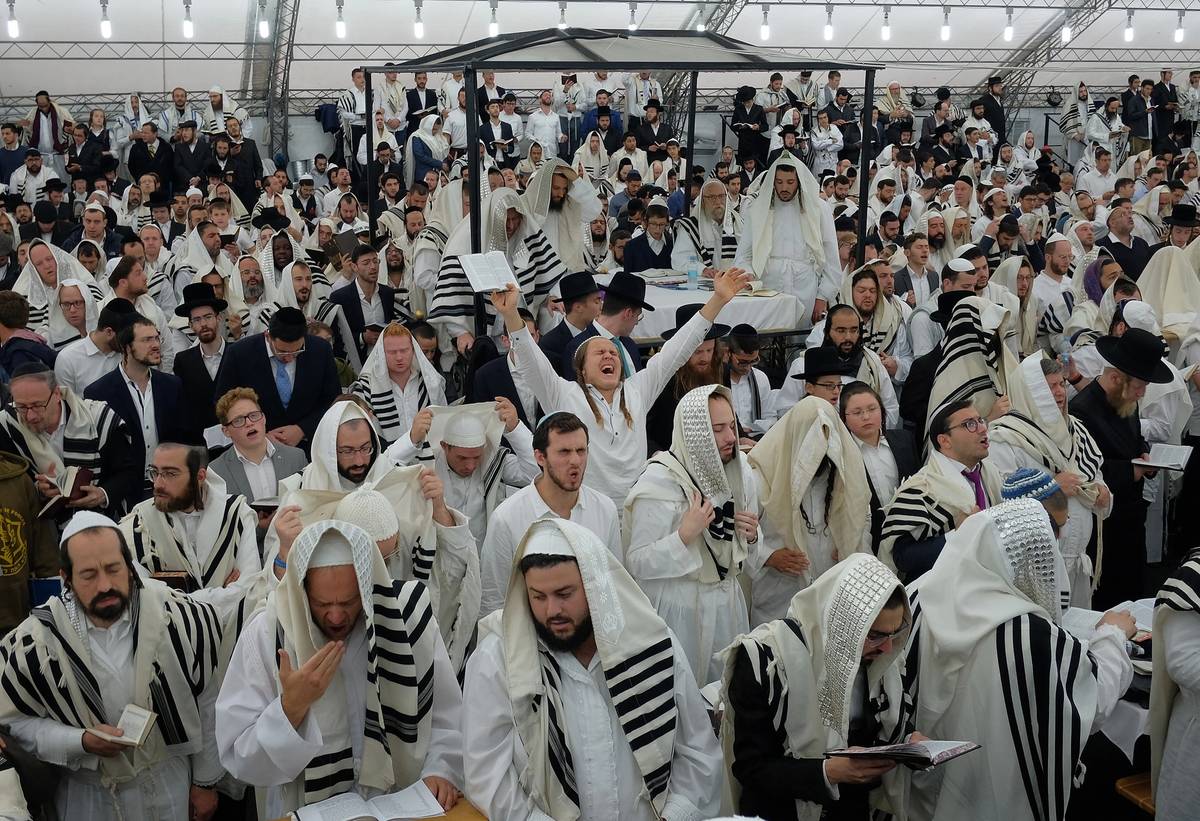
We passed the faded ornate exterior of what was once a Jewish old-age home, and arrived in an empty lot beside an industrial-looking red brick building. “There’s long life and there’s long days,” Bashe said of Rabbi Nachman’s time in Uman. “Here, he had long days.” In his final few months in Uman, the rebbe completed his so-called Burned Book, a work of insights so mind-bendingly profound that on his deathbed he ordered Rabbi Nosson of Breslov, his dynamic younger assistant and amanuensis, to destroy it. Rabbi Nachman dictated densely allegorical fictional stories to Nosson, and wandered the nearby Sobieska arboretum as part of his practice of hitbodedut—out-loud direct address of God, which Rabbi Nachman taught that anyone can do, ideally for an hour each day, preferably in the darkness before dawn. Ravaged by tuberculosis, Rabbi Nachman prepared himself and his followers for his impending death.
A modest stone monument next to the brick building marked the site of the house where Rabbi Nachman died. In 1810, the far hillside was a cemetery, marking the spot where those 20,000 martyrs were buried. “Rabbi Nachman looked over the hill, and said: This is a very holy place,” Bashe explained, his voice at a reverent hush. “These souls need to be rectified … He understood that by being buried here he would bring a higher level of kiddush.”
Rabbi Nachman has become a unifying personality in modern Judaism. He is known to the secular and the very religious, beloved by Kabbalists and Yiddishists and quoted in the Conservative movement’s High Holiday Machzor. Israeli soccer stadiums and Jewish American summer camp singalongs echo with his most famous words, the rabbi’s ever-startling challenge that “the whole world is a narrow bridge, and the important thing is not to fear.” Simple in his broad strokes and infinitely complex in his details, there is no single authority that exists to explain and interpret him, no living rebbe or movement that can claim him in his entirety. The Uman pilgrimage is decentralized. There’s no one religious movement or organization running things.
Some of Rabbi Nachman’s current popularity owes to an emphasis on interiority which some see as an Old World Hasidic precursor to modern psychology—he theorized how someone’s inner state determines the rest of their being, and then used his insights to bolster a prescient belief in the possibility of self-improvement. The mysteriousness of Rabbi Nachman’s life and persona place him in the lost world of the shtetl while allowing him to seem alive in our own present day.
The Nachman-heads in Uman didn’t fit any single description: There was the man who did hitbodedut during chemotherapy, the blissed-out hippie kid who came to Uman over the previous Hanukkah and simply never left, the manager of a bagel shop in Miami, the white-bearded man in a shtreimel and white robes with the faint outline of a tattoo around his right ring finger; lawyers and psychiatrists who came to Nachman later in life, and now study his work over Zoom. Stories about the rabbi emerge even during casual interactions. Rabbi Nachman expects great things of you without judging you. He had gotten people out of jams at work and helped them find wives. He’d calmed the chaos in people’s minds and hearts—for one young rabbi, study of Rabbi Nachman was the only thing that had saved him from a life of depression and institutionalization. He in turn told the story of a recovering heroin addict who decided to study in a yeshiva in Israel after learning about Rabbi Nachman and doing just a single hour of hitbodedut.
In one pamphlet widely distributed in Uman, titled “The Gift of Rosh Hashanah,” the writer recalls entering Rabbi Nachman’s tomb and feeling “HaShem smile on me,” at which point his entire life was transformed. In the past, the tomb is said to have been the site of even uncannier events: A 19th-century Hebrew text relates the story of an aging and mild-mannered rabbi who touched the memorial cenotaph and suddenly remembered all of his previous lives and reincarnations, recalling his identities and relationships with Jewish sages reaching all the way back to the time of the Mishna.
Rabbi Nachman did not believe in guilt as a spur to deeper spirituality. He taught that there is no such thing as despair. This didn’t let anyone off easy, though: The rabbi was as shtark as shtark can be, a legal stickler even by Haredi standards. He taught that the world is a trap, full of things meant to separate the mind and spirit from God. There is a tradition I heard in Uman that Rabbi Nachman once picked up a Greek-language book that two secular Jews were studying. That isn’t for you, one of them said. Rabbi Nachman flipped through the book, and then astonished everyone by discussing its contents in fluent Greek. Tradition also has it that Rabbi Nachman was a mathematical savant and a very good chess player.
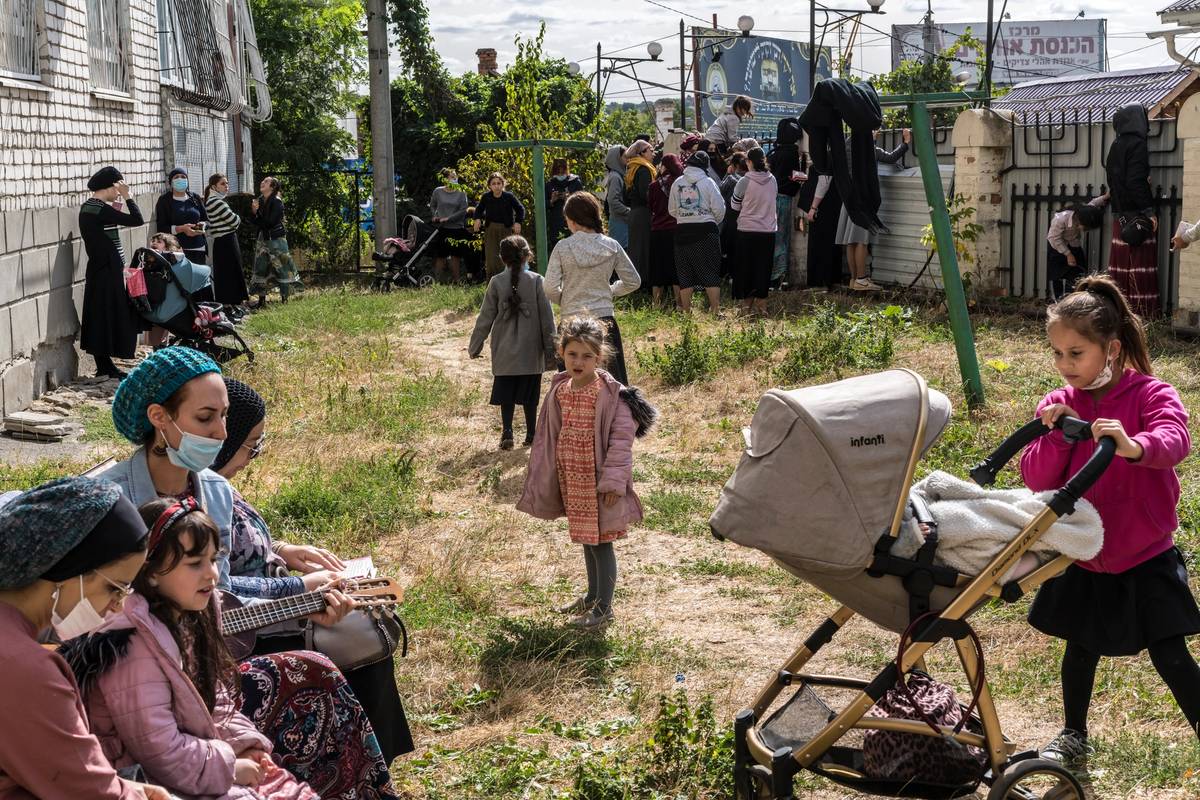
Yet no miracles are attributed to Rabbi Nachman—no one ever claims that he violated or transcended any of the rules of time and space, at least not in life. Of course, for the mystic there is nothing so insignificant that it can’t be considered miraculous. One day, Rabbi Nosson broke a shoelace, and left to get it fixed. Rabbi Nachman stopped him: Pray for the shoelace’s repair, he admonished, before explaining that prayer is the difference between humans and animals, who receive everything they need from nature, and thus don’t need to pray. Rabbi Nachman believed that in prayer, we are supposed to be as much ourselves as possible, a reflection of our true mental and spiritual condition, however sad or joyous or distracted it might be. “Reb Nachman writes that when a person davens a person shouldn’t force emotion,” said Binyomin Weinrib, a Lakewood rabbi I met in Uman. “Don’t try to make yourself cry, don’t try to make yourself laugh, don’t try to make yourself happy. Just be.”
Coming to Uman, Weinrib told a tent full of listeners during a lesson he gave before the holiday, has little to do with developing the intellect. “We’re not here for chachma. We’re not here to gain more knowledge.” Instead, “we’re here to feel something.” Rabbi Nachman “is going to teach me how to have a life that is vibrant, a life that is alive.” The great return and repair one attains in Uman revives the mind-state that seemingly irreversible processes of biology and life experience have completely erased in many or even most people, he explains. Being with the rebbe on Rosh Hashanah restores the radiant pure being of childhood. “We’re missing that chiyyus,” said Weinreib, using a Hebrew word that literally translates to “life-ness.” “When we visit the tzaddik, we get back that chiyyus we had when we were little kids.”
If the Uman experience resets the self to something purer and simpler, the same is also true on a communal scale. You will not go hungry in Uman, where there is a vast apparatus of tents and banquet halls, funded by a small handful of rich Americans and Israelis. Barriers dissolve, and everyone feels like a potential friend. The Uman spectacle suggests a deep Jewish yearning to join together for some single purpose, even if it’s temporary. Back in the U.S., Jews of different religious and political outlooks are increasingly siloed from one another, and the collapse of a formerly vibrant institutional life muddles whatever already vague fellow-feeling existed between a suburban reform Jew and a Satmar in Williamsburg. In Uman, those two people can find themselves talking together over lunch. In America, they’d never meet.
Perhaps Uman has become such a major event because of the ease with which a sense of shared Jewish existence can be reimagined there. It’s a blank slate—or at least a blanker slate than Jerusalem or Monsey—a place made lively by an atmosphere of vanquished historical horror and collective yearning. “This is what the Beis Hamigdash will be like,” a beaming Brooklyn Hasid said to me in the middle of Pushkina, moments after the holiday ended.
Of course Ukraine isn’t any more of a blank slate than anywhere else, and Uman, with a year-round Jewish population of around 300 people, isn’t really an island of Jewish endurance amid blood-soaked plains of wheat and sunflower. Uman Rosh Hashanah is undeniably powerful, and for many it is life-changing, somewhere near the absolute pinnacle of spiritual experience. Yet part of its power comes from its being such an exception to normal reality. It’s compelling because of what it omits.
A little of that normal reality can be found by walking 10 minutes from Uman’s Jewish area to the downtown’s main avenue. In a leafy median there’s a memorial to the dozen or so residents of the city that have been killed fighting Russian-backed separatists in Ukraine’s war-torn east. A block away is a monument to the “Heavenly Hundred,” the scores of demonstrators massacred in Kyiv’s Maidan Square in 2014 during protests against Russian efforts to control the country. It is a dangerous illusion to think that history is ever over, but it feels especially not over in Ukraine, in ways that can disorient an American Jew. For instance, in Kyiv there is a synagogue founded by Jewish refugees from the fighting in Donetsk, whose loss to the separatists is another enduring trauma from 2014. In Ukraine you can meet Jews who were displaced by European armed conflict all of seven years ago.
Uman was not my first stop in Ukraine last September. A week before Rosh Hashanah I had landed in Lviv, in the country’s northwestern corner. The city is almost the opposite of Uman, in that it is famous and incredibly beautiful. The spires of its cobblestoned historic center resemble cake toppings and rocket ships; there are art nouveau spider webs and knockoff Renaissance palazzos and austere medieval towers built across the centuries, back when the city was an occasionally bloody flashpoint where Poles, Russians, Ukrainians, Hungarians, and Jews all met. A historic marker on Serbska Street notes that in 1555, Jews were responsible for 32.5% of the city’s trade in oxen. In the present day, Meylakh Sheykhet informed me, the city lacks even a single kosher grocery store—the meat for the few remaining people who need it is brought in from Vienna, eight hours to the west.
Skeykhet has spent most of his life in Lviv, aside from a brief detour to San Diego, where living as a Soviet-born observant Jew must have been too easy and too peaceful for him. He has a long beard that accentuates a vaguely rabbinic bearing. A former engineer who kept up Jewish observance in secret under communism, Sheykhet has become both famous and controversial in Ukraine, including among Jews, for being a strident opponent of efforts to redevelop land where Jews are believed to be buried.
We spent a whirlwind afternoon seeing things the confectionary tourist wonderland of central Lviv works to conceal: We stopped at a weedy overgrowth in a forest clearing on an industrial estate, a World War II mass grave in imminent danger of being built over. At the site of the former Janowska concentration camp, where perhaps a quarter-million people died, Sheykhet sang "Kel Maaleh Rachamim" while gazing into a thick forest. The former camp, mostly occupied by a modern-day prison, is marked with a couple of crumbling plaques off the side of a highway and nothing more. A tattered memorial banner read, “The City Was (Not) Destroyed,” which bothered Sheykhet—it could do without the parentheses, he said. Sheykhet alleged that in Uman, a Jewish theme park had been built atop a cemetery in order to profit unscrupulous developers. “No studies have been done of how to preserve the site, and this has brought corruption,” claimed Sheykhet. He fielded constant phone calls, updates on the progress of his numerous lawsuits across his country. “My aim is to show: Whatever they try to do against Jews, they are not succeeding—they did not succeed,” Sheykhet said. “They” includes Nazis and communists, but also alleged corrupt antisemites at various levels of government.
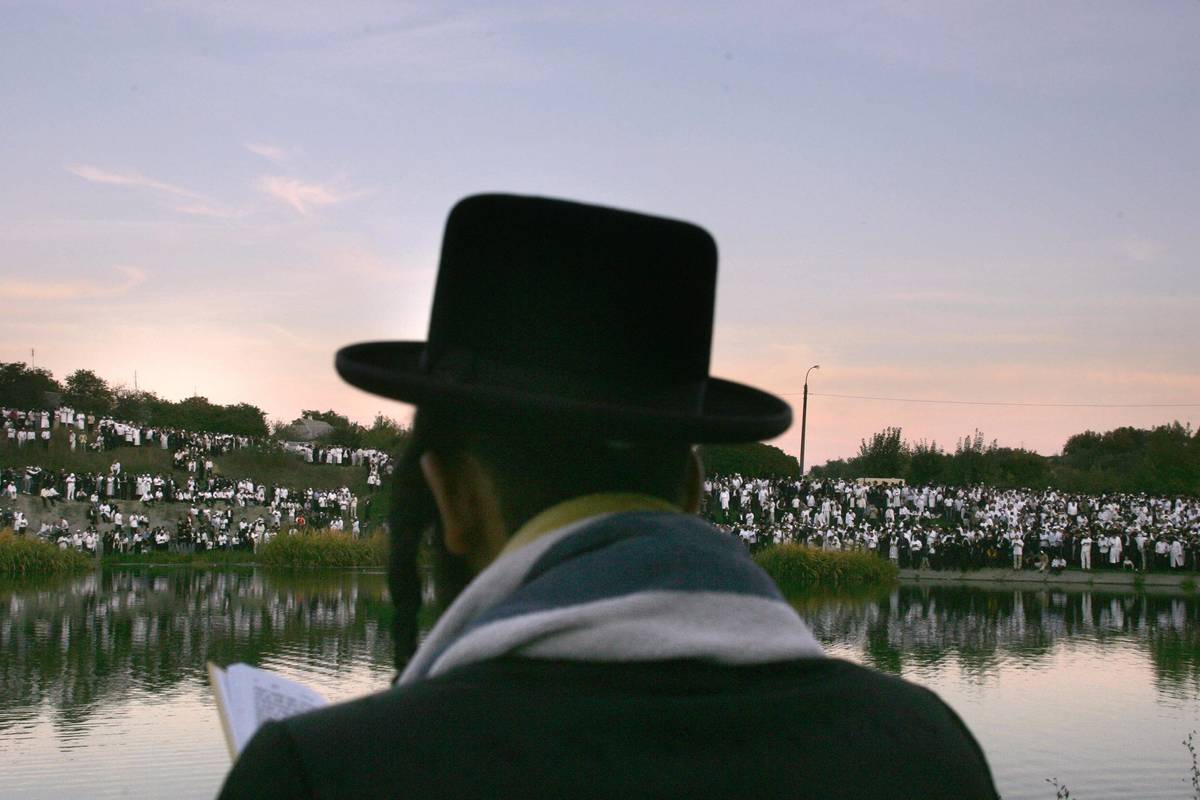
Toward the end of the day, as the sky darkened behind the spires of the old city, Sheykhet and I stood at a bend in the road next to what had once been Lviv’s Jewish hospital, a Moorish-style cluster of domes and towers. Beneath this road was a cemetery that was once considered the equal of Prague’s in terms of the number of great rabbis buried there, Skeykhet said. The road was of Soviet construction, and the cemetery, which the Nazis destroyed, appears in this spot in surviving prewar maps of the city.
Cars whipped by every few seconds, their drivers ignorant of what was beneath them. Nearly everyone in Lviv was ignorant of it. A solid wall of buildings lined one side of the street. Do you really expect the local government to move an entire road, I asked? Sheykhet seemed unbothered by the practicalities. “Let them spend the money,” he smiled. “They’re legally obligated ... I’m already in court for recognizing this part of the cemetery.”
It was absurd to expect the road to vanish, but shameful, in a way, not to expect it. It is the shame of history being allowed to slip away that explains Sheykhet’s work—he is the most disquieting kind of dreamer, one who dreams that the darkness won’t be ignored. He possesses a mad faith in history’s possible reversal, driven by a conviction that the last repositories of memory shouldn’t go quietly.
There is a similar holy madness on display in Uman. The pilgrimage is a place and an experience meant to be outside time, space, and rationality. But in getting Jews further from the world and closer to Rabbi Nachman, Uman Rosh Hashanah becomes the brief and unstoppable reversal of an old and in some sense ineradicable despair. For a few days, the road is moved.
Armin Rosen is a staff writer for Tablet Magazine.